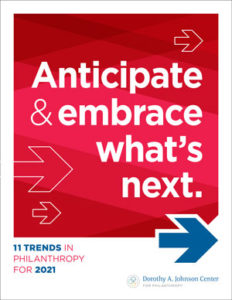Philanthropy’s Next Gen Is Starting to Make Big Changes


 The emergence of the next generation is by definition a “trend” to watch in any field. As the younger generation begins entering the workforce and taking professional roles, they bring new needs, new ideas, new desires and demands. This leads to necessary adaptation and changes to practice. This is certainly true in the field of philanthropy.
The emergence of the next generation is by definition a “trend” to watch in any field. As the younger generation begins entering the workforce and taking professional roles, they bring new needs, new ideas, new desires and demands. This leads to necessary adaptation and changes to practice. This is certainly true in the field of philanthropy.
The next-gen-driven transformations in philanthropy seem more dramatic than just normal generational succession. Today’s next gen — especially millennials and Gen Zers — is by many accounts revolutionizing giving and the nonprofit sector, while raising core questions about philanthropy itself in unprecedented ways. They are reconfiguring the donor landscape, upending norms in nonprofit organizational practice, and even blurring sector boundaries in ways that are redefining how people think of the best way to “do good.”
The next gen is — or soon will be — influencing everyone and everything connected to philanthropy.
To understand the trends being pushed by the current next gen, we have to recognize that we live in a more multigenerational world than at any point in history. People are living longer and staying active as donors, volunteers, and philanthropic professionals longer. As the older members of Gen Z enter adulthood (some are already in their 20s), they begin their careers in nonprofit organizations where baby boomers and perhaps even members of the “silent” or “Greatest” generations still work and/or serve on the board. It is not unheard-of for four generations of giving families be engaged in their joint philanthropic enterprise, and very common for three gens to sit together at the board table.
So, the changes brought by the rising next gen are emerging in this multigenerational context. And this can often lead to difficulty and friction, especially to the extent that the next gen becomes increasingly bold and the older gen remains resistant.
It is clear that so-called “next gen donors” are not just fundamentally transforming giving, but redefining the role of philanthropy in society and rethinking what being a “changemaker” entails. Research on millennials (currently aged 24–39) overall shows that while they still give their time, talent, and treasure, they want a closer and more active relationship with the groups they support, and with other supporters (Influence|SG, 2020 & Case, 2019). As the book Generation Impact reports, those next gen donors with the capacity for major giving — whether deriving from their own wealth creation, or due to their inheritance of a historic wealth transfer — similarly want to be more hands-on, and to learn and give with their peers (Goldseker & Moody, 2020). This new cohort of big donors (including Gen Xers, currently aged 40–55) embraces many of the fast-emerging, boundary-blurring innovations in how to deploy their considerable wealth for good. In fact, they are willing to change whatever they need to about accepted philanthropic practice in order to try to achieve greater impact.
“[Next gen donors] are reconfiguring the donor landscape, upending norms in nonprofit organizational practice, and even blurring sector boundaries in ways that are redefining how people think of the best way to ‘do good.’”
Beyond the “how” of giving, the next gen also sees the role of the philanthropic sector fundamentally differently than previous generations. They do not consider supporting traditional nonprofits to be the only way to “do good” and advance the causes they are so passionate about. As one recent commentary notes, “millennials are everyday changemakers,” preferring to make intentional acts of social good in all aspects of their life — including in their careers, consumer decisions, and political activities (Case & Yu, 2017). They want to organize movements and support campaigns. They want to use their market power — as a particularly large generational cohort — to force change — e.g., by buying sustainable or fair-trade products, or taking jobs at socially responsible companies.
In short, the rising generations of donors want to give and to create change in a variety of different ways. They see giving to nonprofits as just one option — and often not the best one.
It is no secret that the events of 2020 greatly impacted and reshaped the workplace. Yet those watching closely had already noted how, with millennials coming to represent the largest population in the workforce, and Gen Z hot on their heels, organizations and working norms were already being revolutionized before the crises of this year (Fry, 2020). And nonprofit organizations were already undergoing these same changes.
Both generations were told growing up they could make a difference in this world, and as adults they are actualizing this belief. These generations see their time (as employees or volunteers) as being as important as money to support causes they believe in. Compared to prior generations, more millennials and Gen Zers expect their professional roles and their passions to be in alignment (Korngold, 2018). They are also more focused on mission and issue loyalty than on brand or organization loyalty (Case, 2019). This means that while the next gen has a natural affinity for nonprofit careers, they don’t see working for a nonprofit as the only way to do good in their professional lives. Many will prefer to work for a socially responsible, triple bottom line company, or a hybrid organization like a B Corps. This will have implications for the nonprofit workforce, of course.
These emerging generations have also grown up with an abundance of volunteer opportunities, and in many cases community service was even required of them at some point. They certainly want to give their time and talent as well as their treasure, and to do so in meaningful, direct ways. Volunteer managers in nonprofits are now adapting to these highly motivated but somewhat demanding cohorts of new volunteers.
Board service is, of course, a particularly important volunteer activity. While millennials and Gen Zers currently hold less than 17% of nonprofit board seats, according to BoardSource (2017), they are extremely eager to increase that number substantially. This presents both an opportunity and a challenge to nonprofits.
Nonprofit organizations have to be keenly aware of the dynamics that come with having a multi-generational board. What motivates baby boomers to serve — and how they prefer to engage — is different from millennials or Gen Zers, and understanding these differences is pivotal for the onboarding and retention of next gen board members, as well as the smooth functioning of multi-gen boards. Smart nonprofits are starting to ramp up mentoring programs as well, not only to build skills among the next gen but to help create essential cross-generational relationships.
If done right, one great benefit of better engaging the next gen as nonprofit professionals, volunteers, and board members is that they can help the organization live into a commitment to diversity, equity, and inclusion. This is not only because of the commitment of the next gen to these ideals, but also because of the sheer fact that younger generations are much more diverse than any that have come before. Gen Z is almost evenly split between people of color and white people (Parker & Igielnik, 2020).
The crises of 2020 have revealed this emerging next gen revolution in philanthropy even more vividly, as the next gen has jumped onto the frontlines in responding to these crises. For example, next gen members of giving families have been pushing those families to increase their foundation payout, to take risks and try new tools like no-interest loans, to incorporate an explicit racial justice lens in their giving decisions, and much more (Moody & LaJoie, 2020).
More broadly, millennials and Gen Zers of all financial levels have responded using all the tools in their toolbelts — and even invented some new tools. They have changed their purchasing habits to support local and BIPOC-owned businesses, joined and/or organized movements and demonstrations, used their social media to call attention to injustices and push for change, and more. Some observers are saying that the resurgence of the Black Lives Matter (BLM) movement in 2020 will be a generation-defining influence on Gen Z (Laughlin, 2020). Compared to other generations, members of Gen Z are more likely to support BLM and participate in a BLM-related protest, and to engage in frequent conversations around racial justice and related issues (Laughlin, 2020).
These next gen responses to 2020 are not one-time actions or temporary reactions to an unusual time. They are illustrations and expressions of where the next gen intends to take philanthropy in the coming decades. And these changes that the next gen is bringing will require fundamental adaptation in our field, from the advisors who work with next gen philanthropists to the nonprofits who connect with them as volunteers or board members. The good news is that the next gen is anything but apathetic about making changes, whether through philanthropy or some other means.
Philanthropy will not “return to normal” after 2020. Because of the next gen, it will never be the same.


BoardSource. (2017). Leading with intent: 2017 National index of nonprofit board practices. Author. https://leadingwithintent.org/wp-content/uploads/2017/11/LWI-2017.pdf
Case, J. (2019, July 26). Key takeaways from a decade of millennial research. [Blog]. The Case Foundation. https://casefoundation.org/blog/key-takeaways-from-a-decade-of-millennial-research
Case, J., & Yu, E. (2017, March 14). Millennials: The rise of the everyday changemaker [Blog]. The Case Foundation. https://casefoundation.org/blog/millennials-the-rise-of-the-everyday-changemaker
Fry, R. (2020, April 28). Millennials overtake baby boomers as America’s largest generation. Pew Research Center. https://www.pewresearch.org/fact-tank/2020/04/28/millennials-overtake-baby-boomers-as-americas-largest-generation
Goldseker, S., & Moody, M. (2020). Generation impact: How next gen donors are revolutionizing giving. Updated and expanded edition. John Wiley and Sons.
Influence|SG. (2020, June). Influencing young America to act. Cause and Social Influence special report. https://www.causeandsocialinfluence.com/2020research-june
Korngold, A. (2018). 2018 Better world leadership: Nonprofit board leadership study. Korngold Consulting, LLC. https://alicekorngold.com/wp-content/uploads/2020/11/2018-Better-World-Leadership-Report-1.pdf
Laughlin, N. (2020, June). How Gen Z is responding to the Black Lives Matter protests and the implications for brands. New York: Morning Consult. https://go.morningconsult.com/rs/850-TAA-511/images/Gen%20Z%27s%20Response%20to%20BLM%20and%20Implications%20for%20Brands.pdf
Moody, M., & LaJoie, D. (2020, October 14). How family giving can bring about the change America needs now. Chronicle of Philanthropy. https://www.philanthropy.com/article/how-family-giving-can-bring-about-the-change-america-needs-now
Parker, K., & Igielnik, R. (2020, May 14). On the cusp of adulthood and facing an uncertain future: What we know about Gen Z so far. Pew Research Center. https://www.pewsocialtrends.org/essay/on-the-cusp-of-adulthood-and-facing-an-uncertain-future-what-we-know-about-gen-z-so-far